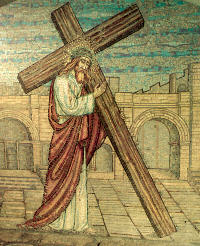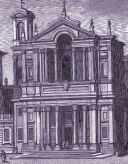From CatholicCulture.org:

Daily Readings for:March 27, 2012
Move to: Previous Day | Next Day

The Station in Rome was formerly the church of the martyr St. Cyriacus, and as such it is still given in the Roman missal; but this holy sanctuary having been destroyed, and the relics of the holy deacon translated to the church of St. Mary in Via lata, it is here that the Station is now held.
The most comprehensive treatment of the Liturgical Year available online: daily reflections, saints, seasons, calendars, prayers, activities, and recipes.

Daily Readings for:March 27, 2012
(Readings on USCCB website)
Collect: Grant us, we pray, O Lord, perseverance in obeying your will, that in our days the people dedicated to your service may grow in both merit and number. Through our Lord Jesus Christ, your Son, who lives and reigns with you in the unity of the Holy Spirit, one God, for ever and ever.
Lent: March 27th

 Tuesday of the Fifth Week of LentOld Calendar: St. John Damascene, confessor and doctor
Tuesday of the Fifth Week of LentOld Calendar: St. John Damascene, confessor and doctor
Move to: Previous Day | Next DayBut one of them, Caiaphas, who was high priest that year, said to them, "You know nothing at all; you do not understand that it is expedient for you that one man should die for the people, and that the whole nation should not perish." He did not say this of his own accord, but being high priest that year he prophesied that Jesus should die for the nation, and not for the nation only, but to gather into one the children of God who are scattered abroad (Jn 11:49-52).
According to the 1962 Missal of Bl. John XXIII the Extraordinary Form of the Roman Rite, today is the feast of St. John Damascene. His feast in the Ordinary Form of the Roman Rite is celebrated on December 4.
Meditation - Christ's Last Days
Every person who loves Christ now tries his best to remain close to his suffering Savior during the last hours of His earthly life. The liturgy places us directly in the midst of the recorded events and expects us to participate. During these next days, therefore, we will traverse each road with Jesus.
Every person who loves Christ now tries his best to remain close to his suffering Savior during the last hours of His earthly life. The liturgy places us directly in the midst of the recorded events and expects us to participate. During these next days, therefore, we will traverse each road with Jesus.
Yesterday (Friday) He came with His disciples from the desert village of Ephrem to Jericho. When near the Jordan we heard from His lips the third prophecy of the crucifixion. Then Salome approached with her two sons, John and James, and begged important positions for them in the coming kingdom. This gave Jesus the opportunity to proclaim His wonderful teaching on humility. We stand close and listen.
The Lord enters Jericho. I am Zacheus, the chief publican, the little man who wants to see the Messiah from a tree. He looks up to me and says, "Today salvation has come to your house!" He stays two nights with me, a despised publican!
Over the Sabbath Jesus remains in Jericho. The next day (Sunday) He starts for Jerusalem at the head of a lordly caravan. Along the road there sits a blind beggar. It is I, again. "Jesus, Son of David, have mercy on me!" He heals my eyes, I see, I am enlightened!
In procession we pass through Jericho's inhospitable ravines up to Jerusalem. Night intervenes and Jesus stops at Bethany. He is joyously welcomed by Martha and Mary. Am I an active Martha or a meditating Mary? Possibly it was on this Sunday evening that the memorable meal took place when, with Lazarus present and Martha as hostess, Mary poured out the costly ointment for Jesus' burial. It was the act which estranged Judas completely from his Master.
In solemn procession on Monday afternoon the King of Israel comes to the top of Olivet, weeps over Jerusalem, and then continues on to the temple. We feel ourselves part of this festive procession, waving palms in our hands. We accompany our King and watch Him drive the money-changers out of His Father's house. Tuesday morning He returns with His disciples and while crossing Mt. Olivet curses the unfruitful fig tree, a figure of the Jewish people. This barren tree is likewise a warning for us.
Verbal encounters with the Jews take place in the temple courtyard until Wednesday afternoon when Christ hurls His eightfold curse upon Pharisee and Jew, and leaves the temple forever. With His disciples He then proceeds to the Mount of Olives and delivers His powerful discourse on the end of the world and the destruction of Jerusalem. Present in spirit we hear this sermon and take to heart His final admonition, "Be vigilant!" Meanwhile Judas has left the circle of disciples and offers his assistance to the chief priests.
Thursday morning Christ sends Peter and John from Bethany into the city to make the needed preparation for the Passover meal. As evening falls He bids farewell to His mother and His friends and goes with His apostles to the Upper Room in Jerusalem for His "Last Supper" with them.—In mind and in heart we will follow our Blessed Lord closely during these sacred days of Holy Week.

The Station in Rome was formerly the church of the martyr St. Cyriacus, and as such it is still given in the Roman missal; but this holy sanctuary having been destroyed, and the relics of the holy deacon translated to the church of St. Mary in Via lata, it is here that the Station is now held.

No comments:
Post a Comment